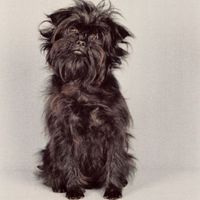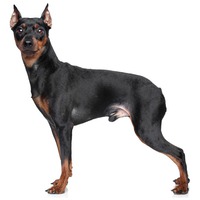
Miniature Pinscher / Zwergpinscher, Min Pin, King of the Toys

Breed history:
This breed is over 300 years old and belongs to the Pinscher-Schnauzer family. In Germany, this breed was acknowledged in 1895 and in North America in 1929. It is appreciated and spread in many countries in Europe and especially in the United States, where this breed has a fanclub.
Description:
This dog is a miniature copy of the German Pinscher, it is small, lively, hefty, with well- allocated muscles. The head is long, the skull is flat, with a medium size, conical muzzle that ends in a round and dark nose. The eyes are medium-sized, slightly egg-shaped and dark. The ears are drooping but can be cropped proportional to the head to stay erect. The tail is docked and kept high. The fur is short, straight, soft, glossy and close to the body. It can be one-coloured or bicoloured: rusty, brown, red, fawn to black, and black with brown or brick patches.
Personality:
It is a clever, pleasant, active, lively, alert and watchful dog that is confident in its own power and barks at any occasion. It is devoted to its master, cautious with strangers and accepts children around it, if they don't tease it too much. It gets along well with other dogs and other household animals. It rarely tends to become aggressive towards other dogs.
Grooming:
This dog's fur needs an occasional brushing during the shedding period.
Living conditions:
It can live both outdoors or in a flat. Although it has a medium level of activity, it likes exercise and play. It needs socialization and training.
Training:
It can be easily trained because it is able and eager to learn. It must be socialized with other animals from an early age, to avoid any possible conflicts with other dogs and other animals.
Usefulness:
It was used in the past to catch rats. Today, it is used as a watchdog for the house and as a companion dog.


Austrian Shorthaired Pinscher
Austrian Pinscher, Osterreichischer Kurzhaarpinscher, Österreichischer, Österreichischer Pinscher



